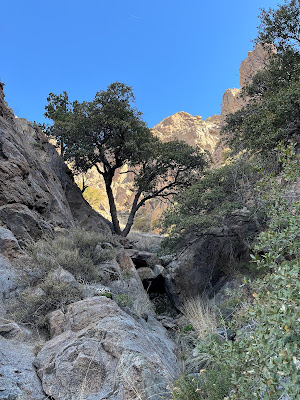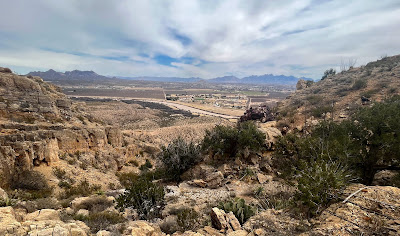 |
Juniper
 |
 |
| Shadow of yours truly at the first drop |
I've been out to Split Rock Canyon a half dozen times. It's the best of the several " pour-off " canyons on the east side of the Robledos. I've been to a couple of other ones further south, and several further north as well, but it struck me as strange that I hadn't even looked at the canyon that is immediately to the south of Split Rock until a very recent Google Earth session spying for new hikes. Stanger still, is that it, while definitely coming in second to Split Rock for dramatic impact and scenery, appeared more than worthy of an investigation. This happens sometimes, the hiding in plain sight phenomena, as thorough as I try to be. Neglected no more, I set out on last Monday (4/13/23) afternoon initially utilizing the Ridgeline Trail of the Prehistoric Trackways NM, before descending down into canyon.
Oddly, initially there were a series of cairns that appeared to guiding me down the hill. I'm thinking these are leftover from the bicycle trail days of the Robledos.
 There didn't seem any two wheeled traffic utilizing the route now. Eventually, as the cairns headed right, I continued left and entered the canyon. This is a much shorter canyon than Split Rock and the effects of erosion are much less pronounced. While the hike in Split Rock is easy stroll on a mostly flat stream bed. This canyon, which I'm dubbing either Juniper or Prospect Canyon, is more like giant steps roughly carved out of the massive limestone bedrock.
There didn't seem any two wheeled traffic utilizing the route now. Eventually, as the cairns headed right, I continued left and entered the canyon. This is a much shorter canyon than Split Rock and the effects of erosion are much less pronounced. While the hike in Split Rock is easy stroll on a mostly flat stream bed. This canyon, which I'm dubbing either Juniper or Prospect Canyon, is more like giant steps roughly carved out of the massive limestone bedrock.

Along the way are a few of the ancient and mighty junipers that somehow survive, for at least hundreds (as much as a thousand?) of years I would guess, in the inhospitable conditions of these steep ravines that pierce the east side of the range.

In a short distance, I was at the precipice of the first drop off. I could see two more as the canyon curved and then straightened on its brief trip to the Rio Grande.

I walked up and out to the north side where there several holes in the hill, with meager tailings, that are the mining prospects.

 The rock they were digging in, a strange looking mix of purple, red, orange white, was apparently all gangue with no ore. This rock runs in a seam along the east face of the mountains for quite a distance. It is in sharp contrast to the grayish marine limestone and doesn't appear to sedimentary in origin, though I don't know what it is.
The rock they were digging in, a strange looking mix of purple, red, orange white, was apparently all gangue with no ore. This rock runs in a seam along the east face of the mountains for quite a distance. It is in sharp contrast to the grayish marine limestone and doesn't appear to sedimentary in origin, though I don't know what it is.

I didn't return quite the way I came. I headed back down and then in and out of the canyon following old bike/cattle/wildlife trails (of which there myriad in this part of the Robledos) circling around, crossing a few smaller drainages, until I was back at the cairns that had led me down off of the Ridgeline Trail.
NOTE: while most of this hike was in the Prehistoric Trackways National Monument, Prospect/Juniper Canyon is just over the boundary in the Robledo Mountains Wilderness, part of the Organ Mountains-Desert Peaks National Monument.
Labels: big trees, fossils, geology, hiking, Organ Mountains/Desert Peaks National Monument, Robledo Mountains Wilderness, waterfalling
































































